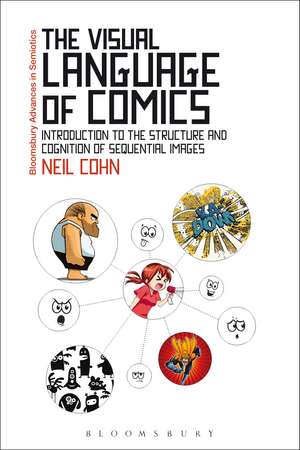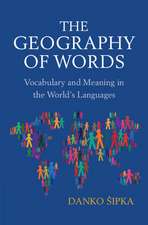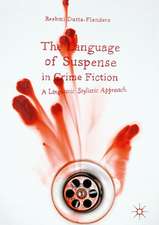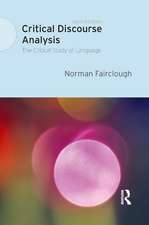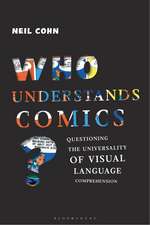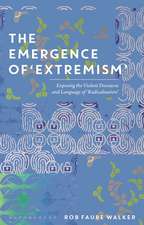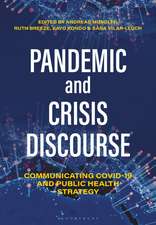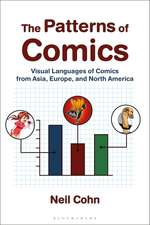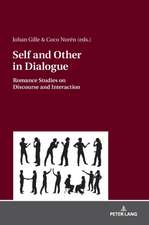The Visual Language of Comics: Introduction to the Structure and Cognition of Sequential Images.: Bloomsbury Advances in Semiotics
Autor Dr Neil Cohnen Limba Engleză Paperback – 4 dec 2013
Din seria Bloomsbury Advances in Semiotics
- 14%
 Preț: 179.13 lei
Preț: 179.13 lei - 22%
 Preț: 271.40 lei
Preț: 271.40 lei - 22%
 Preț: 256.85 lei
Preț: 256.85 lei -
 Preț: 173.71 lei
Preț: 173.71 lei - 30%
 Preț: 568.71 lei
Preț: 568.71 lei - 14%
 Preț: 171.77 lei
Preț: 171.77 lei - 14%
 Preț: 1006.79 lei
Preț: 1006.79 lei - 23%
 Preț: 190.96 lei
Preț: 190.96 lei - 23%
 Preț: 198.05 lei
Preț: 198.05 lei - 13%
 Preț: 231.16 lei
Preț: 231.16 lei -
 Preț: 198.22 lei
Preț: 198.22 lei - 13%
 Preț: 232.07 lei
Preț: 232.07 lei - 13%
 Preț: 237.28 lei
Preț: 237.28 lei - 13%
 Preț: 258.42 lei
Preț: 258.42 lei - 24%
 Preț: 190.16 lei
Preț: 190.16 lei - 8%
 Preț: 299.19 lei
Preț: 299.19 lei - 23%
 Preț: 192.30 lei
Preț: 192.30 lei - 18%
 Preț: 306.47 lei
Preț: 306.47 lei - 22%
 Preț: 257.32 lei
Preț: 257.32 lei - 22%
 Preț: 223.58 lei
Preț: 223.58 lei - 30%
 Preț: 773.39 lei
Preț: 773.39 lei - 22%
 Preț: 226.79 lei
Preț: 226.79 lei - 22%
 Preț: 238.40 lei
Preț: 238.40 lei - 23%
 Preț: 192.73 lei
Preț: 192.73 lei - 22%
 Preț: 237.84 lei
Preț: 237.84 lei - 22%
 Preț: 1007.62 lei
Preț: 1007.62 lei - 8%
 Preț: 131.83 lei
Preț: 131.83 lei - 18%
 Preț: 305.53 lei
Preț: 305.53 lei
Preț: 238.84 lei
Preț vechi: 292.81 lei
-18% Nou
Puncte Express: 358
Preț estimativ în valută:
45.70€ • 47.72$ • 37.82£
45.70€ • 47.72$ • 37.82£
Carte disponibilă
Livrare economică 14-28 martie
Livrare express 27 februarie-05 martie pentru 73.97 lei
Preluare comenzi: 021 569.72.76
Specificații
ISBN-13: 9781441181459
ISBN-10: 1441181458
Pagini: 240
Ilustrații: 81
Dimensiuni: 156 x 234 x 15 mm
Greutate: 0.42 kg
Editura: Bloomsbury Publishing
Colecția Bloomsbury Academic
Seria Bloomsbury Advances in Semiotics
Locul publicării:London, United Kingdom
ISBN-10: 1441181458
Pagini: 240
Ilustrații: 81
Dimensiuni: 156 x 234 x 15 mm
Greutate: 0.42 kg
Editura: Bloomsbury Publishing
Colecția Bloomsbury Academic
Seria Bloomsbury Advances in Semiotics
Locul publicării:London, United Kingdom
Caracteristici
It describes the only model that explicitly integrates narrative across comics, film, and verbal discourse.
Notă biografică
Neil Cohn is an internationally recognized scholar for his research on the overlap of sequential images and language in cognition. He is the author of Early Writings on Visual Language and Meditations.
Cuprins
Chapter 1. Introducing Visual LanguageSECTION 1: STRUCTURE OF VISUAL LANGUAGEChapter 2. The Visual Lexicon, Part 1: Visual morphologyChapter 3. The Visual Lexicon, Part 2: Panels and ConstructionsChapter 4. Visual Language Grammar: Narrative StructureChapter 5. Navigation of External Compositional StructureChapter 6. Cognition of Visual LanguageSECTION 2: VISUAL LANGUAGE ACROSS THE WORLDChapter 7. American Visual LanguageChapter 8. Japanese Visual LanguageChapter 9. Central Australian Visual LanguageChapter 10. The Principle of Equivalence
Recenzii
[Neil Cohn's] theory, presented in The Visual Language of Comics, is provocative . If he is right, the hidden logic of cartoon panels could provide new vistas on art, language and creative development.
[Cohn's] work exhibits a dogged quest for rigour that gives this book an authoritative tone. [ . . . ] Perhaps the biggest question the book asks is one that demands consideration by any current or future researcher: 'why should the brain create several unique and diverse ways to handle different behaviours when it can efficiently make use of various general underlying structures'? Those with the desire to answer . . . will find this book a thoughtful and useful companion to their studies.
The most unified and accessible explanation of the theory [of visual "language"] this far.
Cohn's book represents a major break away from previous discussions of linguistic structures in other media ... He manages to combine a sophisticated theory model with much needed empirical experiments ... This is an innovative approach for comic book research, connecting systematic linguistics and cognitive studies in new ways that are a valuable extension of previous discussions.
Cohn writes succinctly, using language familiar to discourse analysts ... [and] draws on the work of others as well as his own original research.
Neil Cohn thinks about the comics medium and visual literacy on very deep and enlightening levels. In The Visual Language of Comics, Cohn shares his research and insights on how the mind works when processing sequential visuals. It's fascinating reading for anyone interested in visual communication.
Neil Cohn is diving deeper into comics and the brain than anyone I know now.
Neil Cohn's The Visual Language of Comics is a smart, carefully organized, and exceptionally well-argued work of comics scholarship. I suspect it will become one of a very small number of truly crucial texts in the burgeoning field of comics studies. The book provides an original yet persuasive account of the relationship of comics and language and introduces key terms and conceptual distinctions that are likely to become part of the common sense of comics analysis and criticism. It also explores the ways in which comics have been used as tools of communication and self-expression across a variety of cultural contexts. Over the past decade Neil Cohn has published a number of important research articles on comics that make use of his training in linguistics, psychology, and neuroscience. The Visual Language of Comics builds on this interdisciplinary scholarship but it also offers new insights and opens up new avenues of inquiry. Recommended for anyone with an interest in comics, language, and what Richard Gregory calls "the eye-brain system."
Being able to tell stories with images is an important and perhaps unique human ability. Neil Cohn has done us all a favor, by analyzing how we can use a visual language theory to analyze comics and other forms of graphic communication; to think deeply about language and the mind. His years of deep thinking, and research, show in this new and provocative book
In this pioneering book, Neil Cohn opens up a whole new domain of cognitive science: the study of how we derive meaning from sequential images.While borrowing much of his approach from theoretical linguistics and psycholinguistics, Cohn is careful to let the character of the phenomena speak for themselves, appealing to a rich and fascinating selection of examples from a wide range of graphic traditions.His results illuminate the parallels and sharpen the differences among different human cognitive systems.
This book offers more than the title implies, transcending The Visual Language of Comics to reveal the structural, rule governed system that constitutes the visual language used in many forms of contemporary communication. One of the most interesting aspects of Cohn's work is his exploration of the lexicon and grammar of visual language as employed in "dialects" that vary across cultures. Cohn's arguments are rigorous, but clearly, even entertainingly, supported with scores of visual examples and explanations.
After reading this book you'll never look at comics the same way, and your view of language will be broadened as well. Neil Cohn is a linguist, a cognitive psychologist, and a graphic artist. In this pathbreaking book he brings his diverse skills together to explore and reveal underlying structures of visual language. Careful study of visual narrative in several cultures shows that comics are beautifully patterned and generative, comparable to language and music. Cohn elaborates what he calls the "visual-graphic modality of language," pointing to a wealth of research possibilities in cognitive neurology, psycholinguistics, and cultural anthropology.
Neil Cohn introduces a new and rigorous set of tools for discussing comics and visual narrative that will influence practitioners as well as academics. His arguments confirm many intuitions of cartoonists about the way comics work while at the same time deflating numerous others. I believe it will significantly enrich the discourse in this still-developing area of study.
Combining expertise in psychology and linguistics with skills in draftsmanship, Cohn explores the analogies between comics and verbal language with exciting results. By unveiling patterns in all stylistic dimensions of comics' visuals, this book is not just indispensable reading for comics scholars, but also constitutes a major contribution to the discipline of visual studies more generally.
Very useful to introduce students to the core elements of comics and to show them how meaning is conveyed by pictorial elements.
Very coherent good level of theory and terminology.
[Cohn's] work exhibits a dogged quest for rigour that gives this book an authoritative tone. [ . . . ] Perhaps the biggest question the book asks is one that demands consideration by any current or future researcher: 'why should the brain create several unique and diverse ways to handle different behaviours when it can efficiently make use of various general underlying structures'? Those with the desire to answer . . . will find this book a thoughtful and useful companion to their studies.
The most unified and accessible explanation of the theory [of visual "language"] this far.
Cohn's book represents a major break away from previous discussions of linguistic structures in other media ... He manages to combine a sophisticated theory model with much needed empirical experiments ... This is an innovative approach for comic book research, connecting systematic linguistics and cognitive studies in new ways that are a valuable extension of previous discussions.
Cohn writes succinctly, using language familiar to discourse analysts ... [and] draws on the work of others as well as his own original research.
Neil Cohn thinks about the comics medium and visual literacy on very deep and enlightening levels. In The Visual Language of Comics, Cohn shares his research and insights on how the mind works when processing sequential visuals. It's fascinating reading for anyone interested in visual communication.
Neil Cohn is diving deeper into comics and the brain than anyone I know now.
Neil Cohn's The Visual Language of Comics is a smart, carefully organized, and exceptionally well-argued work of comics scholarship. I suspect it will become one of a very small number of truly crucial texts in the burgeoning field of comics studies. The book provides an original yet persuasive account of the relationship of comics and language and introduces key terms and conceptual distinctions that are likely to become part of the common sense of comics analysis and criticism. It also explores the ways in which comics have been used as tools of communication and self-expression across a variety of cultural contexts. Over the past decade Neil Cohn has published a number of important research articles on comics that make use of his training in linguistics, psychology, and neuroscience. The Visual Language of Comics builds on this interdisciplinary scholarship but it also offers new insights and opens up new avenues of inquiry. Recommended for anyone with an interest in comics, language, and what Richard Gregory calls "the eye-brain system."
Being able to tell stories with images is an important and perhaps unique human ability. Neil Cohn has done us all a favor, by analyzing how we can use a visual language theory to analyze comics and other forms of graphic communication; to think deeply about language and the mind. His years of deep thinking, and research, show in this new and provocative book
In this pioneering book, Neil Cohn opens up a whole new domain of cognitive science: the study of how we derive meaning from sequential images.While borrowing much of his approach from theoretical linguistics and psycholinguistics, Cohn is careful to let the character of the phenomena speak for themselves, appealing to a rich and fascinating selection of examples from a wide range of graphic traditions.His results illuminate the parallels and sharpen the differences among different human cognitive systems.
This book offers more than the title implies, transcending The Visual Language of Comics to reveal the structural, rule governed system that constitutes the visual language used in many forms of contemporary communication. One of the most interesting aspects of Cohn's work is his exploration of the lexicon and grammar of visual language as employed in "dialects" that vary across cultures. Cohn's arguments are rigorous, but clearly, even entertainingly, supported with scores of visual examples and explanations.
After reading this book you'll never look at comics the same way, and your view of language will be broadened as well. Neil Cohn is a linguist, a cognitive psychologist, and a graphic artist. In this pathbreaking book he brings his diverse skills together to explore and reveal underlying structures of visual language. Careful study of visual narrative in several cultures shows that comics are beautifully patterned and generative, comparable to language and music. Cohn elaborates what he calls the "visual-graphic modality of language," pointing to a wealth of research possibilities in cognitive neurology, psycholinguistics, and cultural anthropology.
Neil Cohn introduces a new and rigorous set of tools for discussing comics and visual narrative that will influence practitioners as well as academics. His arguments confirm many intuitions of cartoonists about the way comics work while at the same time deflating numerous others. I believe it will significantly enrich the discourse in this still-developing area of study.
Combining expertise in psychology and linguistics with skills in draftsmanship, Cohn explores the analogies between comics and verbal language with exciting results. By unveiling patterns in all stylistic dimensions of comics' visuals, this book is not just indispensable reading for comics scholars, but also constitutes a major contribution to the discipline of visual studies more generally.
Very useful to introduce students to the core elements of comics and to show them how meaning is conveyed by pictorial elements.
Very coherent good level of theory and terminology.
